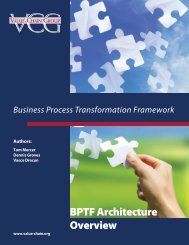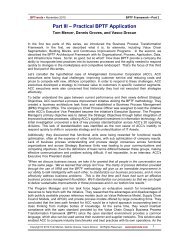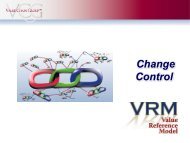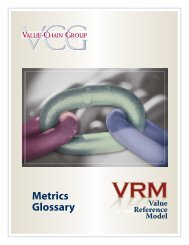Transitioning from - Value Chain Group
Transitioning from - Value Chain Group
Transitioning from - Value Chain Group
Create successful ePaper yourself
Turn your PDF publications into a flip-book with our unique Google optimized e-Paper software.
T R A N S I T I O N I N G F R O M S & O P T O I B P<br />
practice. A different name helps companies<br />
to foster the change <strong>from</strong> the current “S&OP”<br />
process to a new, and significantly more<br />
impactful, improved business process along with<br />
new leadership and management behaviors.<br />
S&OP & IBP - What is the Difference<br />
Figure 6 shows the primary differences between<br />
a more mature Integrated Business Planning<br />
process <strong>from</strong> “Sales and Operations Planning”<br />
as currently implemented by many companies.<br />
The Maturation Phases of S&OP/IBP<br />
We are frequently asked: “Why do some<br />
companies fully evolve their S&OP process<br />
into Integrated Business Planning and most<br />
companies do not.” The maturation of S&OP<br />
into IBP goes through four stages. (See Figure 7)<br />
As companies move <strong>from</strong> Stage 1 to 2 and<br />
begin to move into Stage 3, they realize<br />
significant benefits and performance<br />
improvements. Often the problems that<br />
stimulated the implementation in the first<br />
place are dramatically reduced or eliminated<br />
altogether. It is, therefore, easy to stop<br />
progressing through Stages 3 and 4. Companies<br />
get “stuck” in between Stage 2 and Stage 3.<br />
Figure 6 – The Difference Between S&OP and IBP<br />
Without leadership participation and action,<br />
the process cannot develop into a fully-mature<br />
Integrated Business Planning process. Since<br />
Stages 3 and 4 involve moving more into the<br />
area of strategy, the company leadership team is<br />
required to champion the effort or progress, or the<br />
accompanying significant benefits will simply not<br />
be made.<br />
Those companies that have only implemented<br />
S&OP to the Stage 2 level will find themselves with<br />
a process that helps to more effectively operate<br />
the business. They may not be in a position to gain<br />
a competitive advantage, however. In fact, they<br />
Stage 1 - Improved Communications<br />
The process has begun. There are regularly-scheduled S&OP process reviews. The data is not yet complete or trustworthy. However,<br />
issues are surfaced and discussed. This improved communications phase usually lasts through monthly cycles 1 through 4.<br />
Stage 2 - Problem Solving<br />
The regularity of the process is established. The data has improved…more complete and more trustworthy. The data shows there<br />
are problems and/or opportunities that need to be addressed in the “now” timeframe. Decisions are made and executed. This<br />
problem-solving phase usually is between cycles 3 and 6.<br />
Stage 3 - Problem Prevention<br />
The process becomes more mature, disciplined, and regular. The near-term problems have largely been addressed. The management<br />
team begins focusing further out in the planning horizon. Anticipated problems are identified; decisions are made to<br />
preclude the problems <strong>from</strong> occurring. Phase three usually occurs <strong>from</strong> cycles 5 through 9.<br />
Stage 4 - Strategic and Tactical Decision-Making<br />
The process has matured. Its effectiveness in identifying and enabling the solving and prevention of problems is clearly understood.<br />
The management team begins to focus on closing the gap between the current reality (“bottom-up” view) and the<br />
business’s strategic goals and “top-down” objectives. The management agenda tends to shift <strong>from</strong> problems to opportunities.<br />
The data is the best the company has, and it is used to set the expectations for the following fiscal year, i.e. the numbers drive<br />
the annual planning process.<br />
In practice, there are elements of all phases occurring in each cycle, but the above is a reminder that in<br />
an S&OP/IBP implementation, there is a natural progression to a fully-capable and best-practice process.<br />
6<br />
Figure 7 – Four Stages of Progression with S&OP/IBP







